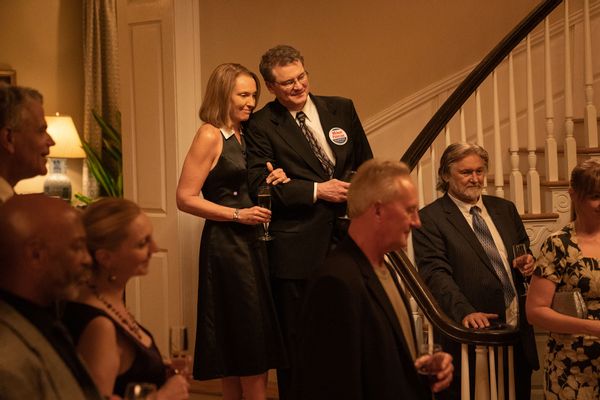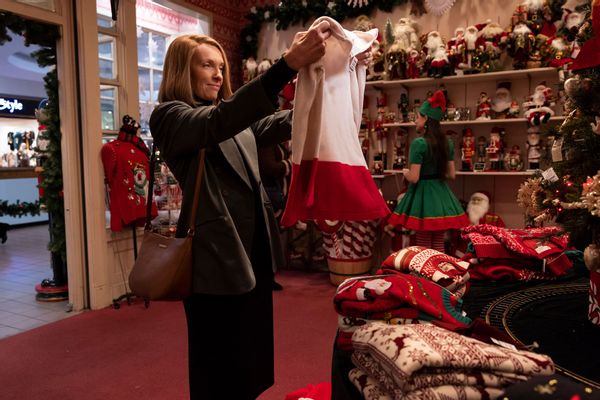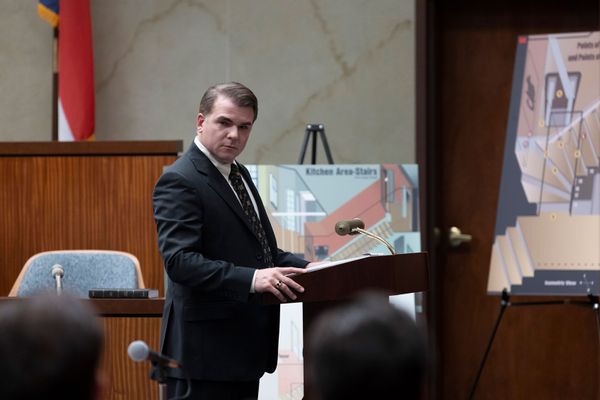Making the bodies of “The Staircase”: The challenge of depicting Kathleen both in life and in death
In “The Staircase,” Kathleen Peterson (Toni Collette) falls. Later, we see her fall again and again. We see the violence from multiple angles, in present time and reenacted by investigators trying to figure out what happened, what killed the woman who died in 2001 and if her husband, writer Michael Peterson, had anything to do with it.
But in the first episode of the HBO Max series, we see the aftermath of the violence in difficult, lingering detail for the first time (there will be other times). We see the body, its stillness, its horrible silence. And it looks real.
RELATED: Before stepping into “The Staircase,” let’s take a swoop through The Owl Theory
This is certainly not the first time this story has been told and may not be the last. But at its heart is a woman who was lost. How to convey the magnitude of that loss, and also, the shocking and confusing violence that took her from the world?
To make Kathleen seem real, “The Staircase” turned to Collette, who inhabits the role in scene after scene of a woman — an executive, once the first female engineering student at Duke University, a mother and stepmother — who appears dynamic, engaging, loving and full of life. To make her death seem real, and the tragedy it is, series creator, writer and director Antonio Campos turned to Mike Marino, an Oscar-nominated makeup and prosthetic artist.
Marino, who has pictures of “The Staircase” prosthetics and remarkable special effect work on his Instagram [warning: some of the images are graphic] called Campos “a perfect director, because he understands the technical value of effects . . . he’s very aware of each department. And I think that he trusts, much like Martin Scorsese does, trusts his people he hires, and collaborates with them and doesn’t disappear.” Marino’s long list of credits include “Black Swan,” “Batman” and “The Dead Don’t Die.”
But the challenge for Marino and “The Staircase” was that the show is not about monsters, but about a real person who lived and had something monstrous happen to them (and is still the subject of a cold case). How did they make the bodies of “The Staircase,” and how did they recreate a lived life? How does the series walk the line between being respectful and being realistic?
 The Staircase (Photo courtesy of HBO Max)Salon interviewed Campos and Marino as well as “The Staircase” writer/executive producer Maggie Cohn.
The Staircase (Photo courtesy of HBO Max)Salon interviewed Campos and Marino as well as “The Staircase” writer/executive producer Maggie Cohn.
This interview has been edited for length and clarity.
You have such a large cast here, a big, blended family that go through time. What were some of the challenges of showing this real family and their long and complicated relationships?
Antonio Campos: Well, the challenge when you’re telling a story that’s this expansive and that covers a lot of time and ground is okay, so what are the beats? What do we include here? How do we collapse time? Some of that was very subtle because it’s not like people are aging drastically in that amount of time, so you have to figure out how do you communicate that with hair or with makeup? And then, how does the actor, through their performance communicate that they’re older? The way they move or the way they talk.
“She is this ball of life. She is the anchor, she is the glue. And then the minute that she’s gone, the family starts to come apart, the seam starts to tear.”
How do you convey three different timelines, but still make each one feel very present? Because we don’t want the past to feel like the past or the future to feel like the future. They all have to feel like they’re happening at the same time and as urgent. We made them all feel the same in a way.
Everything was so connected and there is this idea that it is all kind of happening at the same time. Even though you know that Kathleen Peterson will die on this day, you still feel like – one of the things we built into the story are moments where something dangerous happens, where she falls off a ladder, where she hits the deer. And then, you have to remind yourself, “Oh, right. There are still months to go.” Playing with the audience’s expectations and making everything again, feel urgent and very present . . . you feel like it’s all happening at the same time.
We get a real sense of Kathleen in the show. And so, we know we’re going to lose her and the loss is going to hurt.
Campos: I think the thing with Kathleen, when you watch the documentary, you feel her absence, but you also feel there’s a void because it’s like, who is this person? So often in documentaries, in crime documentaries, the deceased is just that. There is a photograph or fleeting images in home movies.
 The Staircase (Photo courtesy of HBO Max)Part of the series that we were so excited about was to try and breathe life into our version of Kathleen and to find the person that could complicate her and make her multidimensional and multifaceted. And we always knew that – I mean, there was no one else in our mind besides Toni Collette, because immediately, you knew that there was going to be this kind of performance that she was going to give that would be so human and layered and have light and dark and everything in between.
The Staircase (Photo courtesy of HBO Max)Part of the series that we were so excited about was to try and breathe life into our version of Kathleen and to find the person that could complicate her and make her multidimensional and multifaceted. And we always knew that – I mean, there was no one else in our mind besides Toni Collette, because immediately, you knew that there was going to be this kind of performance that she was going to give that would be so human and layered and have light and dark and everything in between.
“In true crime, the victim is typically expressed as an absence. It’s the last of the person.”
Basically the way Toni’s schedule worked out on the shoot was she would come in for her block and we would shoot her scenes first and then she would be gone for like the next three or four weeks, and then she’d come back. When she would leave, you would all of a sudden feel that energy just disappear. It really felt like all of a sudden, oh, Kathleen’s gone. You would feel that shift in the energy. In a way, that is what happens after Kathleen dies. She is this ball of life. She is the anchor, she is the glue. And then the minute that she’s gone, the family starts to come apart, the seam starts to tear.
What are some of the challenges of portraying real people like Kathleen? How were you able to create her as a character in a way that felt realistic while still being respectful?
Maggie Cohn: In true crime, the victim is typically expressed as an absence. It’s the last of the person. Of course, that’s what you would do because they’re gone. It’s that absence that then puts things into the sense of the journey. In this case, because of the concurrent timelines we had the opportunity to show what you were missing. Because we showed you who Kathleen was. She was, by all accounts, a very very dynamic woman. And while there’s a lot of disagreement about what happened that night, it’s very infrequent that there’s disagreement about what a compelling person she was.
And that’s not to say that we fully understand who Kathleen Peterson was. It’s not to say that we didn’t take creative liberties, but what we chose to do with her, and by extension, all our real characters is embody an essence that seemed to be the most pronounced characteristic that they had . . . She was a mother, a wife, a sister, daughter. She was a businesswoman. She was involved in her community. She was incredibly intelligent. She broke the glass ceiling at her college . . . What an ascent to our story. And the fact that she’s no longer with us, it’s something that we can investigate. And something we can learn from.
The victim is not an afterthought; she’s really present here. But then we also have the body, which is very present too, different than anything I’ve seen before: after the fall and in the autopsy. How did you construct that body? And what were the creative decisions in deciding how to show it and how to make it?
Mike Marino: There’s multiple bodies. There’s this staircase body where she does fall down the stairs and is laying in this uncomfortably contorted position, this very specific way that almost like a dead body only can hold . . . [We asked] “Why don’t we just use Toni Collette to lay there?” We realized that’s probably a bad idea because there’s so much technical work that has to go on. There’s blood matching, there’s completely laying still for long period of time. If she has to get up and go on breaks, is the continuity going to be ruined? So, we said, “Let’s just make a totally realistic fake body that can get in that position and stay there.”
“That is probably why people are saying, ‘Holy s***, that looks really real,’ because it’s almost verbatim her, in a way.”
We 3D-scanned in Toni Collette, her head mostly and hands. We used a body double for her body in the contorted position, found someone that really matched Toni. Because this is a long, long process I didn’t want to put her through, other than the face. We had scanned in the double body nude . . . We made an elaborate rig that she could sit in that mimicked the stairs, at the same angle. We had her lay there and make an expression and we 3D-scanned her. And once the scan is done, it captures everything that’s true to form on Toni.
We 3D-printed the copy that we scanned in of Toni, added some textures, some eyeballs, things like that. Once we printed the 3D print, we made a mold of it and cast it out in clay. And the clay version was further detailed, and the sculpture of that was made. And then we made another mold of that, and then we cast it in silicone. Now the body was a complete 3D print that was designed to bend and be jointed and move and all of this. So, like a giant toy . . . you can bend it and move it in any kind of position.
We put it all together, and it looked like an exact version of her. I airbrushed it and painted it with the little intricacies and color changes and veins. It’s an elaborate process, but we did something on this job that not many studios are doing . . . I think it’s worth it, because what you’re able to achieve is a hyper-realistic perfect representation of Toni in a very complicated position. That is probably why people are saying, “Holy s***, that looks really real,” because it’s almost verbatim her, in a way.
 The Staircase (Photo courtesy of HBO Max)Another thing that feels different to me is the violence. It’s very real, but it’s also technical. We have the investigators trying to recreate the blood splatter, which we see in such detail. It feels in this show, like we understand more the consequences of violence. Can you talk about the creative decision making what went into how you wanted to show violence?
The Staircase (Photo courtesy of HBO Max)Another thing that feels different to me is the violence. It’s very real, but it’s also technical. We have the investigators trying to recreate the blood splatter, which we see in such detail. It feels in this show, like we understand more the consequences of violence. Can you talk about the creative decision making what went into how you wanted to show violence?
Campos: Yeah, it’s hard. I’ve always felt compelled to do it in a way that is real and visceral but not sensational . . . We really felt like the right way and the right language within our series was to almost be a fly on the wall. To take an objective perspective and imagine: Well, if there were cameras there that night and you could see, where would they be? And they couldn’t move. And if someone kind of dips in and out of frame, that’s what happens.
“If you’re going to pick violence, it’s always going to be uncomfortable.”
We started to explore this idea that we were going to let the action of either the fall, or the beating as is the case in Episode 4, just play out in basically real time. And for us – as painful as that felt — it also felt like the way to not be commenting, to not be going: look here, look here, look at this blood spatter, look at this impact. It was like: No, this is what it looks like. And this is how it could have happened if it happened, like this or like that.
It felt, by cutting, the other thing you’re doing is you’re commenting. The minute you make a cut into something, into a close-up, you’re really saying something to the audience. Anytime you put an image on a screen and cut from one thing to another, you’re obviously making a suggestion. We’re trying to limit that as much as possible and to give the sense of objectivity. We found our angles and then allowed the action to unfold in them.
Something that then became very important in post was to do our best to not cut on a moment of action . . . What we really tried hard to do is to allow, say, a fall or a hit to happen in a frame, wait, and then cut so that we weren’t sensationalizing any of the action, we were kind of letting it happen.
If you’re going to pick violence, it’s always going to be uncomfortable if you’re trying to do it in a realistic way. But because there are images of this crime scene, there are images from autopsy table, these are things that we felt like we had to try and be true to.
Want a daily wrap-up of all the news and commentary Salon has to offer? Subscribe to our morning newsletter, Crash Course.
Something I appreciate about this storytelling too is that it’s complex, it’s complicated.
Cohn: We wanted to posit a lot of questions and some of those questions we’d answer within the same episode and some of those questions are going to play out throughout the entirety of the season.
Campos: At the end of the day, our hope is that you arrive at a place of accepting the not knowing. People are so uncomfortable with uncertainty and the idea that you can’t know something, and so they force themselves to make a decision to say, this is the answer. And what we hope for at the end is that you can accept that there is gray and that there are things that we just do not know. You have to learn how to live with those things.
“The Staircase” finale debuts Thursday, June 9 on HBO Max.
More stories like this:

